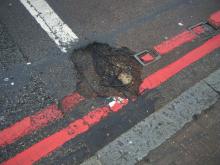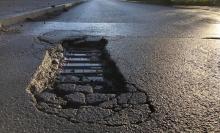More than 3,900km of roads in England and Wales will need essential maintenance within the next year, according to the annual ALARM survey*
Cash-strapped local governments are reporting that the gap between the funds they received and the amount they needed for repairs and maintenance was almost €639 million. This equated to an average shortfall of €3.75 million for every authority. It would take 14 years to get local roads back into a reasonable steady state, but only if adequate funds and resources were available, notes the 23rd edition of the ALARM (Annual Local Authority Road Maintenance) Survey, produced by the
Qualitative feedback suggests that maintenance underfunding over many years takes the resultant condition off the projected and planned deterioration curves, resulting in more effort and cost to get the network back to target condition.
There has been little change in the overall structural road condition reported in England and Wales with the percentage of roads considered good (with 15 or more years of life remaining), fair (5-15 years of life remaining), and poor (less than five years of life remaining), staying stable.
The exception is London, where the percentage of roads classed as good has increased to 51% (2016/17: 45%), while those classed as fair has dropped by a third to 26%. The percentage of the network classed as poor in the capital also rose, from 16% last year to 23% – an increase of 43%.
Overall, 20%, or one in five local roads, is now rated as poor – having less than five years of life remaining. This is equivalent to around 64,500km of local roads.
Pothole pique
Since 2015, when the number of potholes filled reached record levels, almost 2.7 million, the number filled each year has been steadily declining. This trend continues, notes the report. “This is a positive move as it may reflect a shift towards more efficient whole-life asset management.”
The decrease by region is reported as: 14% in England; 21% in London; and 7% in Wales. Nevertheless, potholes are symptomatic of poorly maintained roads and potential underlying structural issues.
At 1.5 million, the total number filled is equivalent to one pothole being repaired every 21 seconds in England and Wales.
Around 65% of authorities responding to the ALARM survey use the guideline depth of 40mm to define a pothole, with this definition largely unaffected by the introduction of the new Well-managed Highway Infrastructure Code (see box). As the effect of a pothole can vary dramatically depending on its location and the nature of traffic, depth definition is not always the only means of prioritising repairs.
The disparity in cost between filling potholes as part of a planned programme of carriageway repairs and as a reactive repair is again apparent. Taking an average cost for filling a pothole across each region, the total amount spent in England and Wales is estimated at almost €108 million, the lowest figure reported since ALARM 2014. Local authorities are spending an average of nearly €1.5 million (11%) of their annual maintenance budget on premature maintenance arising from utilities openings. Opening a road to create a trench can reduce its structural life by up to 30%. The continuing high level of utility openings in England and Wales can have a detrimental effect, even though the majority (85% based on responses received) are completed in accordance with legislation.
Difficult choices to be made
“Although local authorities report an increase in average highway maintenance budgets this year, looking back over the past decade they have barely kept in line with inflation,” says Rick Green, chairman of the alliance. “This is reflected in road condition, with one in five of our local roads now classed as structurally poor – with less than five years’ life remaining – compared with one in six reported last year."
Sufficient funding for adequate maintenance has fallen short for so many years that further deterioration is inevitable, he explains. “There are difficult choices to be made at both local and national level but the government needs to provide adequate funding for a well-maintained and safe local road network if it wants to support communities and drive economic growth.”
Budget shortfall
The shortfall in the annual carriageway maintenance budget reported this year is €630 million, the equivalent of a funding gap of €3.75 million per authority.
In England the figures show a continued fall from nearly €5.8 million per authority last year to around €3.9 million this year. This decline is also identified in Wales - from €4.2 million to €3.5 million. However, London bucks the trend with a 20% increase in the reported shortfall from just over €2.8 million in 2016/17 to €3.4 million in 2017/18.
The real extent of the shortfall could be being masked by the fact that half (51%) of English and Welsh authorities report transferring capital funds, intended for highway improvements, to supplement traditional revenue budgets for maintenance work. Of course, carrying out road maintenance as part of capital works still leads to highway improvements, regardless of funding stream.
*The full 2018 ALARM survey is available to download by visiting www.asphaltuk.org. Previous annual ALARM surveys can be accessed on www.asphaltuk.org. Other road-related statistics can be found at RoadFile on www.roadusers.org.uk
**The Asphalt Industry Alliance was set up in 2000 by the Mineral Products Association and Eurobitume UK, the two principal bodies which represent suppliers of the raw materials used to produce asphalt, as well as asphalt producers and laying contractors.
From guidance to risk management
The Well-managed Highway Infrastructure Code - a non-statuary code - was published in October 2016 and supersedes the Well-maintained Highways, Well-lit Highways and Management of Highway Structures. The code signals a change away from previous thinking about planned and preventative maintenance that relied upon specific guidance and recommendations.
The 2016 code moves to a risk-based approach determined by each local highway authority. It promotes the adoption of integrated asset management for highway infrastructure based on the establishment of local levels of service through risk-based assessment. It also includes guidance on some additional topics. Some authorities may be able to implement a full risk-based approach immediately. Others may require more time and may choose to continue with existing practices for an interim period.
The latest code, intended to apply throughout the UK, was produced and overseen by the UK Roads Liaison Group and its Roads, Bridges and Lighting Boards. It is recognised that there are differences in approach to some matters in England, Scotland, Wales and Northern Ireland, which are not always detailed in the 2016 code, but general principles are set out.
Local authorities report they are working towards compliance with the code, with 92% in England, 100% in London and 63% in Wales on course to meet the October 2018 deadline.
The UK Roads Liaison Group was set up in 2001 by national and local government authorities to consider road engineering and operation issues. The 2016 code is available free on the group’s website, www.ukroadsliaisongroup.org







